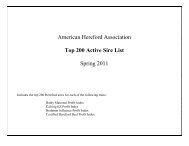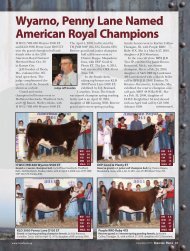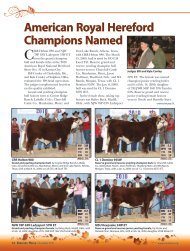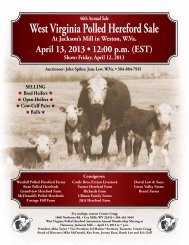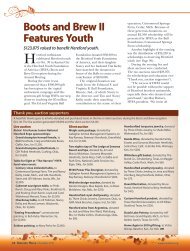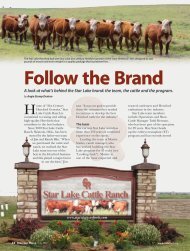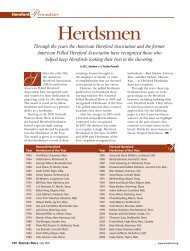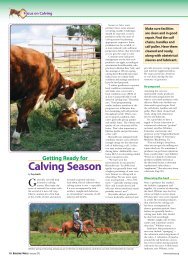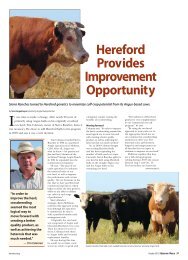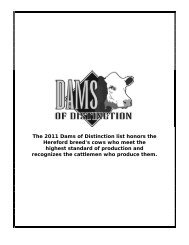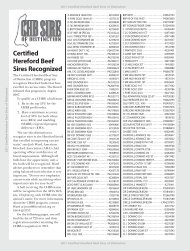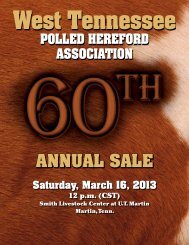Topp Herefords' Common Sense Approach to Marketing
Topp Herefords' Common Sense Approach to Marketing
Topp Herefords' Common Sense Approach to Marketing
Create successful ePaper yourself
Turn your PDF publications into a flip-book with our unique Google optimized e-Paper software.
Potential bull buyers evaluated this year’s <strong>Topp</strong><br />
Herefords’ sale bulls at an open house/bull<br />
preview held on Dec. 3, 2005. Ryan visits<br />
almost every bull buyer’s ranch <strong>to</strong> determine<br />
bull performance, herd needs and how <strong>to</strong> mate<br />
<strong>Topp</strong> cows in the next breeding season.<br />
Pictured below are Ryan and Prairie <strong>Topp</strong>,<br />
owners of <strong>Topp</strong> Herefords, and their children<br />
(l-r) Logan, Lauren and Mariah.<br />
<strong>Topp</strong> Herefords’<br />
<strong>Common</strong> <strong>Sense</strong><br />
<strong>Approach</strong> <strong>to</strong> <strong>Marketing</strong><br />
<strong>Topp</strong>s provide cus<strong>to</strong>mers more than just the bull.<br />
by Teresa Oe<br />
If you ask a <strong>Topp</strong> Herefords’ bull<br />
cus<strong>to</strong>mer why they return year after<br />
year, you’re likely <strong>to</strong> hear, “Ryan does<br />
something I’ve never seen another<br />
seeds<strong>to</strong>ck producer do.” Yet there’s no<br />
secret <strong>to</strong> the magic of his marketing. A<br />
close look at the <strong>Topp</strong> Herefords’ plan<br />
reveals unique and meaningful tactics<br />
that benefit all parties affiliated<br />
with the North Dakota<br />
ranch. Before revealing<br />
these tactics, let’s take<br />
a look at how the<br />
operation became<br />
what is <strong>to</strong>day.<br />
Ranch progression<br />
<strong>Topp</strong> Herefords was established<br />
in 1945 near Grace City, N.D., by<br />
Ryan’s grandfather, Woodrow <strong>Topp</strong>.<br />
Hereford cattle were the mainstay of<br />
the operation. Woodrow’s son, Merlin,<br />
entered as managing partner in 1964.<br />
Woodrow and Merlin annually sold<br />
about 60 bulls, privately, until Merlin’s<br />
death in 1980 at the early age of 38.<br />
The ranch remained intact thanks<br />
<strong>to</strong> Merlin’s wife, Kathy. Kathy later<br />
bought the ranch, and remarried <strong>to</strong><br />
Larry Erickson. They continued raising<br />
cattle. The purebred Hereford herd was<br />
eventually moved <strong>to</strong> commercial status<br />
and, <strong>to</strong> this day, the commercial<br />
unit is a large portion of cattle<br />
numbers at the Grace City<br />
ranch. Three hundred fiftyfive<br />
commercial and 200<br />
purebred cows run at<br />
this location.<br />
While Ryan<br />
and Prairie have full ownership of<br />
<strong>Topp</strong> Herefords, Ryan emphasizes<br />
that it is only a portion of the <strong>to</strong>tal<br />
operation. “The farm and ranch are<br />
very much run as a team,” he says.<br />
“<strong>Topp</strong> Herefords primarily produces<br />
and markets breeding s<strong>to</strong>ck. My father,<br />
Larry, manages the farm production<br />
of small grains and row<br />
crops near Glenfield, and<br />
he and Kathy own most of<br />
the commercial cows. My<br />
brother, Paul, and his wife,<br />
Holly, are heavily involved<br />
in the daily operations and<br />
decisions regarding the<br />
lives<strong>to</strong>ck. They are growing<br />
their own commercial herd<br />
and are owners/opera<strong>to</strong>rs<br />
of <strong>Topp</strong> Professional Services (TPS).”<br />
TPS is responsible for the majority of<br />
the pho<strong>to</strong>graphy in <strong>Topp</strong> Herefords’<br />
marketing pieces.<br />
Ryan and Prairie have two daughters<br />
and a son – Lauren (age 6), Mariah (age<br />
4) and Logan (age 2). Prairie also works<br />
off the farm as a sales manager for the<br />
Sunopta Grains and Foods Group. It’s<br />
clear that Ryan and Prairie have their<br />
hands full. Nevertheless, <strong>Topp</strong> Herefords<br />
takes the time <strong>to</strong> assure that quality is<br />
the program’s No. 1 objective.<br />
Genetics first<br />
Time and time again, we’re <strong>to</strong>ld that<br />
marketing efforts are only as successful<br />
as the product is of quality. A <strong>to</strong>ugh<br />
culling process at the <strong>Topp</strong> ranch<br />
ensures this quality.<br />
<strong>Topp</strong> Herefords breeds about 200<br />
females and also implants roughly<br />
150 embryos from their best cows.<br />
About 80% of the cows are artificially<br />
inseminated, utilizing mainly <strong>to</strong>p bulls<br />
from the ranch’s previous sales, along<br />
with some fresh outcross genetics. If a<br />
female doesn’t breed in 60 days, she is<br />
culled.<br />
About 10% of the heifer calves are<br />
marketed privately. Seventy percent is<br />
retained and the bot<strong>to</strong>m 20% is shipped<br />
<strong>to</strong> market.<br />
26 Hereford World / March 2006 www.hereford.org
Bull calves must endure a three-cut<br />
culling process <strong>to</strong> make the annual sale.<br />
In the spring prior <strong>to</strong> grass turnout, the<br />
high birth weight calves and any calves<br />
out of cows where udder quality or milk<br />
flow is not exceptional are culled. At 7.5<br />
months, weaning weights are taken and<br />
bull calves that don’t wean at least 47%<br />
of their dam’s weight are also culled. A<br />
third cut is made before sale day on any<br />
bull calf not maintaining a minimal daily<br />
gain, not demonstrating good health or<br />
not sizing up <strong>to</strong> Ryan’s standards for eye<br />
appeal. The bull calves that pass the<br />
test are sold in the annual sale held the<br />
first Monday of February at Farmers’<br />
Lives<strong>to</strong>ck in Bismarck.<br />
Genetic improvement is just as<br />
important in the commercial division<br />
as it is on the registered side. Although<br />
<strong>Topp</strong> Herefords started out purebred,<br />
Ryan clearly states that the purpose for<br />
high-quality genetics is <strong>to</strong> ultimately<br />
improve the consistency, uniformity and<br />
quality of the commercial business.<br />
The commercial herd<br />
The commercial cattle herd consists of<br />
250 F1 Hereford-Angus cross females<br />
and 100 Angus females. The heifers are<br />
bred Hereford and Red Angus. <strong>Topp</strong>s’<br />
crossbred herd qualifies their product for<br />
premium programs including Certified<br />
Hereford Beef (CHB) LLC and<br />
Certified Angus Beef.<br />
The commercial baldie females are<br />
bred <strong>to</strong> Hereford and Angus bulls. Ryan<br />
says that this cross gives <strong>Topp</strong>s what<br />
they’re looking for in a replacement<br />
female: “an efficient, low-maintenance,<br />
problem-free animal.”<br />
The Angus herd is mainly bred<br />
Hereford. This wasn’t always the case.<br />
Five years ago, <strong>Topp</strong>s were breeding<br />
the majority of the cows <strong>to</strong> Angus<br />
bulls. “What we found with using a<br />
Hereford bull was we were increasing<br />
our weaning weights dramatically,”<br />
Ryan says. “We were putting in<strong>to</strong> the<br />
feedlot a more efficient converter. But<br />
most importantly, we were able <strong>to</strong><br />
raise F1 replacement females. We see<br />
a dramatic condition difference in our<br />
F1s compared <strong>to</strong> our Angus both on<br />
pasture and through the winter months,<br />
thus lowering our input costs.”<br />
Ryan discovered the benefits of the<br />
Hereford bull through experience. The<br />
underlying question<br />
grows — how is he<br />
encouraging others <strong>to</strong><br />
try the same? How is<br />
Ryan marketing <strong>Topp</strong><br />
Herefords’ bulls?<br />
<strong>Marketing</strong> more<br />
than a bull<br />
In their May 2004<br />
newsletter, <strong>Topp</strong><br />
Herefords announced<br />
their newly formed beef alliance with<br />
Sinner Bros. & Bresnahan (SB&B).<br />
<strong>Topp</strong>s had marketed 100% of their<br />
commercial calves through the SB&B<br />
feedlot for four years and were<br />
appreciative of the professionalism,<br />
honesty and accuracy of the staff.<br />
Similarly, SB&B was taking note<br />
of Ryan’s strengths. Tom Bresnahan,<br />
SB&B partner, says, “We liked Ryan’s<br />
understanding of the breeding process<br />
and his direction, how he was getting<br />
there.” Consequently, an alliance<br />
was formed, and Ryan was no longer<br />
marketing just a Hereford bull, but<br />
a bull loaded with the potential <strong>to</strong><br />
provide a package of valuable <strong>to</strong>ols<br />
that cus<strong>to</strong>mers could use <strong>to</strong> ultimately<br />
improve their bot<strong>to</strong>m line.<br />
When a <strong>Topp</strong> Hereford bull is<br />
purchased, the cus<strong>to</strong>mer has the<br />
option <strong>to</strong> sell his or her calves <strong>to</strong> the<br />
SB&B feedlot. If the calves are bought<br />
by SB&B, the feedlot provides the<br />
producer genetic feedback through<br />
carcass evaluation and extensive feedlot<br />
conversion testing.<br />
<strong>Topp</strong> Herefords’ bull<br />
cus<strong>to</strong>mer, Shane Prill,<br />
likes <strong>to</strong> see “deep,<br />
nice-uddered” cows<br />
such as this one in<br />
<strong>Topp</strong>s’ sale catalog,<br />
even though it’s bulls<br />
that <strong>Topp</strong>s are selling.<br />
Ryan says that this pasture-<strong>to</strong>-plate<br />
process helps commercial producers<br />
increase the uniformity, quality and<br />
consistency of their cattle, which, in<br />
turn, makes their cattle more marketable<br />
and sought after by feeders. “By<br />
going through the harvest data and<br />
determining what’s positive and what’s<br />
negative, you can really strengthen your<br />
overall program,” Ryan says.<br />
He goes further <strong>to</strong> explain that the<br />
alliance is a win-win-win situation. The<br />
commercial producer gets hard data<br />
and a team of industry people working<br />
<strong>to</strong> secure his or her position in the<br />
market place. SB&B gets source-verified<br />
genetics and producer collaboration<br />
from year <strong>to</strong> year. <strong>Topp</strong> Herefords<br />
gets long-term and mutually beneficial<br />
relationships with their bull buyers.<br />
Maintaining relationships<br />
Russ Stein, commercial producer<br />
from Taylor, N.D., hadn’t bought a<br />
Hereford bull in 25 years. He bought<br />
one Hereford bull from <strong>Topp</strong> Herefords,<br />
went back the next year and bought<br />
continued on page 28…<br />
<strong>Topp</strong> Herefords’ bull calves have <strong>to</strong><br />
pass a three-cut culling process <strong>to</strong> be sold in the annual sale. Ryan offers a 100% satisfaction guarantee.<br />
www.hereford.org Hereford World / March 2006 27
…<strong>Topp</strong> Herefords’ <strong>Common</strong> <strong>Sense</strong> <strong>Approach</strong> <strong>to</strong> <strong>Marketing</strong> continued from page 27<br />
two, and the next year, three. “Ryan<br />
comes every year <strong>to</strong> see how the bulls<br />
are doing,” Stein says. He adds that<br />
there aren’t many bull producers who<br />
you even hear from after the sale. To the<br />
contrary, Ryan tries <strong>to</strong> visit almost every<br />
bull buyer’s ranch. “Since he formed the<br />
alliance, you can really see what his bulls<br />
are doing,” Stein says.<br />
Sinner Bros. & Bresnahan<br />
by Tom Bresnahan, SB&B partner<br />
Ryan didn’t only make a testament<br />
for his program, but also for the<br />
Hereford breed. Stein says he prefers<br />
the longevity of Hereford bulls and<br />
that the disposition of his cattle herd<br />
has changed greatly since introducing<br />
Hereford genetics.<br />
Shane Prill, Wichita, Kan., also is<br />
sold on <strong>Topp</strong> Herefords’ bulls. His<br />
Sinner Bros. & Bresnahan (SB&B) partnership was started in 1952 by Bill<br />
Sinner, George Sinner and my father, Ellery Bresnahan (brother-in-law). Over the<br />
years the operation has gradually changed hands <strong>to</strong> Bob Sinner, Dick Sinner, Pat<br />
Bresnahan and myself, Tom Bresnahan.<br />
We farm 4,700 acres, contract additional acres for export and, in 2003,<br />
marketed more than 5,000 cattle.<br />
Finishing cattle has been a big part of our operation over the years. My<br />
grandfather, Albert Sinner, fed cattle as far back as the 1920s. Our parents fed<br />
cattle. And our cattle buyer continues <strong>to</strong> remind me that he was buying cattle for<br />
SB&B when I was in diapers. We have fed many sizes and various breeds of cattle<br />
over the years. Calf producers often want us <strong>to</strong> tell them which breeds we like <strong>to</strong><br />
feed the most. I like <strong>to</strong> tell them a s<strong>to</strong>ry that sort of explains our position.<br />
A few years back, after finishing a day of pheasant hunting in western North<br />
Dakota, we s<strong>to</strong>pped at a local tavern for a cold beer. A cowboy who had heard I was<br />
involved with a feedlot in Cassel<strong>to</strong>n, N.D., came up <strong>to</strong> the table for a little discussion<br />
on cattle. He asked me <strong>to</strong> tell him what I thought was the best type of cattle <strong>to</strong><br />
feed. I knew I had, at best, a 20% chance of guessing the right answer. But he kept<br />
pressuring me and he finally <strong>to</strong>ld me he had some of the best cattle around. “They<br />
<strong>to</strong>pped the market in a South Dakota sale barn last year.” So I asked him, “How do<br />
your cattle grade when they are finished? What percentage are Prime and Choice?<br />
What percentage are yield grade 1 and 2?” He responded with, “Oh, I don’t know<br />
about that, but the guy at the sale barn sure liked ’em.’”<br />
It made us realize that most producers didn’t really know how good or bad<br />
their cattle actually were. For years we had operated on the same system. The<br />
packer would buy our cattle on a flat price per pound with no premiums or<br />
discounts. But the industry was changing; grid-based marketing was helping <strong>to</strong><br />
define which cattle actually earned premiums.<br />
So we focused more on collecting carcass data and doing individual group<br />
close outs on various cattle bunches. We learned whose cattle were earning<br />
premiums or creating discounts. We started charting the weekly changes in the<br />
premiums and discounts. We increased the number of cattle purchased directly<br />
from the farm/ranch, and we increased our focus on grid-based marketing. We<br />
worked on improving prevaccination programs and reducing death loss. We<br />
focused on producers who were willing <strong>to</strong> do what was needed <strong>to</strong> capitalize on<br />
those premiums.<br />
One of the producers was Ryan <strong>Topp</strong>. He wanted the information. He wanted<br />
<strong>to</strong> hear the whole s<strong>to</strong>ry, not just the good stuff. He wasn’t afraid <strong>to</strong> hear the truth.<br />
Together we reviewed carcass data, average daily gain, conversion, yield, finish<br />
weights and death loss percentage. Together we defined what was working and<br />
what wasn’t. Together we addressed industry and market direction. Together we<br />
started an alliance <strong>to</strong> ultimately improve uniformity, predictability and quality. HW<br />
relationship with Ryan began in the<br />
Yards of the National Western S<strong>to</strong>ck<br />
Show in Denver. “I saw the best<br />
Hereford bull I’ve ever seen in the pen<br />
show a couple of years ago,” Prill says. “I<br />
followed Ryan out of the ring and asked<br />
if it was for sale.” This was the beginning<br />
of a strong relationship between the two.<br />
What next attracted Prill <strong>to</strong> buying<br />
<strong>Topp</strong> Herefords’ bulls were the pictures<br />
of females in <strong>Topp</strong>s’ sale catalog. “Ryan<br />
must put eight <strong>to</strong> 10 pictures of cows in<br />
his bull book,” Prill says. Prill’s loyalty <strong>to</strong><br />
<strong>Topp</strong> Herefords is largely due <strong>to</strong> these<br />
“deep, nice-uddered cows.”<br />
Prill has since put enough trust in<br />
Ryan <strong>to</strong> buy bulls unseen. Prill speaks<br />
of a call from Ryan. “He said, ‘This is<br />
exactly what you want, Shane.’” Prill<br />
bought the bull in trust that Ryan had<br />
visited enough with him <strong>to</strong> understand<br />
his herd needs. “It’s the best Hereford<br />
bull I’ve had,” Prill says. “I’ve collected<br />
350 straws and he’s a good son-of-a-gun.”<br />
It appears that many folks are<br />
putting their trust in Ryan, <strong>Topp</strong><br />
Herefords and a vision that drives the<br />
operation and alliance.<br />
The vision<br />
“Ryan is an entrepreneur, a visionary,”<br />
Prairie says of her husband. She talks<br />
of Ryan’s commitment <strong>to</strong> finding new<br />
ways <strong>to</strong> give his cus<strong>to</strong>mers more return<br />
on their investments. “He doesn’t follow<br />
fads. He follows a systematic program<br />
<strong>to</strong> ensure consistency, predictability and<br />
high performance — rather than high<br />
profile — genetics.” Prairie also notes that<br />
Ryan doesn’t try <strong>to</strong> sell the “best bull,”<br />
but instead suggests sire groups based on<br />
specific cus<strong>to</strong>mer needs and feedback.<br />
Bresnahan further explains what<br />
<strong>Topp</strong> Herefords and the producer-driven<br />
alliance with SB&B is all about. “It’s<br />
about using a culling procedure. It’s<br />
about consistency. It’s about uniformity.<br />
It’s about predictability. It’s about quality<br />
improvement. It’s about understanding<br />
the breeding process. It’s about trust<br />
and integrity. It’s about working <strong>to</strong>gether<br />
<strong>to</strong> gain market knowledge. It’s about<br />
marketing opportunities. It’s about<br />
building an alliance. It’s about using<br />
carcass data <strong>to</strong> help improve the value<br />
of a herd. It’s about being ahead of the<br />
industry.” HW<br />
28 Hereford World / March 2006 www.hereford.org



